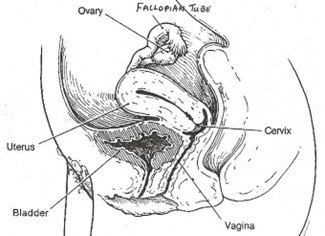The Cervix (also called the neck of the womb)
The cervix is the muscular canal at the lower end of the uterus and is 2cms in length. (lateral view of the female pelvis is shown below). Its upper end opens into the uterine cavity and its lower end into the vagina. The external opening of the cervix is called the cervical os and it is closed for most of the menstrual cycle i.e. during the infertile phases. The cervical os is open during the fertile phase of the cycle and also during menstruation and at the end of pregnancy for the birth of the baby. (see Fig 6-16, page 15 on the LINK Pictures & Diagrams )
‘Palpation of the Cervix’ as a fertility indicator

During the fertile phase of the cycle certain parameters of the cervix change, e.g. its position, texture and the width of the cervical os. These changes are the basis of its use as a fertility indicator and can be observed by the woman herself when she learns how to palpate the cervix.1
The Natural Family Planning teacher must teach the woman how to palpate the cervix and to chart the cervix observations. Palpation of the cervix is easy to learn and after charting her observations for three cycles the woman will become confident in her observations.
CHANGES IN THE POSITION OF THE CERVIX IN THE FERTILE PHASE2
During the fertile phase the cervix moves upwards away from the vaginal opening and around the time of the ‘peak’ mucus symptom, at the time of maximum fertility, the cervix reaches its highest point making it difficult to reach with the finger. This is called the maximum cervix position. During the fertile phase the cervix becomes progressively softer and feels wet due to the presence of mucus and the cervical os will gradually open to admit a finger tip and will be at its maximum width at ovulation. These changes are due to the action of oestrogen.
Any change in position or in consistency of the cervix from its original infertile state indicates the start of the fertile phase2 and usually corresponds with the beginning of the mucus symptom.
CHANGES IN THE POSITION OF THE CERVIX IN THE INFERTILE PHASE
During the infertile phases of the menstrual cycle both before and after the fertile phase, the cervix is low and is easier to reach, it feels firm and dry as the mucus has dried up, and the cervical os is closed. These changes are due to the action of progesterone. The change of the cervix from its ‘maximum’ position with an open cervical os, to a low position and a closed cervical os is abrupt, and it usually occurs on the day following the ‘peak’ mucus symptom.
When is the cervix observation done?
Palpation of the cervix is done once a day in the evening. Palpation of the cervix as a fertility indicator is never used alone, but only in conjunction with another fertility indicator such as basal body temperature (BBT) or cervical mucus.
How long does it take to become familiar with the changes in the cervix?
It usually takes about two or three cycles for the woman to become familiar with these changes in the cervix. The ‘palpation of the cervix’ indicator can be used in combination with either the Basal Body Temperature or the cervical mucus symptom, as one of the two fertility indicators required to define the beginning and/or the end of the fertile phase of the cycle in the symptothermal double-check method of NFP. Its use is defined by the RULES of the symptothermal double-check method of NFP and the woman must be taught these rules by a qualified NFP teacher.
The Cervix as a fertility indicator is very useful in pre-menopause and after childbirth
At certain times during the woman’s child-bearing years ‘palpation of the cervix’ is a very useful fertility indicator when other fertility indicators may be difficult to interpret due to the hormonal changes occurring in the body such as in the pre-menopause and after child-birth.2 In the pre-menopause when fertility is declining, cycle lengths may be irregular and the cervical mucus symptom unreliable, and after childbirth when fertility is returning, cycle lengths may be longer, and the Basal Body Temperature may be erratic.
References:
- Keefe, E.; ‘Self-observation of the cervix to distinguish days of possible fertility’; Bull of the Sloane Hosp for Women; 1962; 129-136
- Flynn A, Brooks M; ‘The Manual of Natural Family Planning’; pages 74-80; 1996; ISBN 0 7225 3115 X


